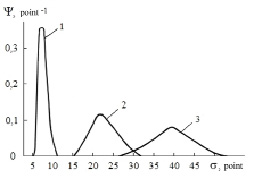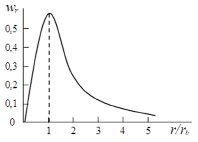The success of any human activity fully depends on its consciousness development level. It is known that determinism of consciousness of an individuum is realized through randomness, caused by inherent random character of its psychic and somatic states [7]. And this reflects in random character of behavior of an individuum in performing certain activity. In this regard non-classical probabilistic-statistical method is used to model behavior of an individuum. This method is also widely used to model behavior of quantum objects (f.e. electrons, atoms, molecules etc.) [2]. In contrast to classic (mass) probabilistic-statistical method this one allows to describe random character of behavior of a large quantity of objects as well as behavior of an individual object, in this regard sometimes it is called individual method [8]. Let us consider the aspects of this method applied to analysis of human and quantum object behavior.
Human behavior modeling
Aspects of random character of behavior of an individuum in the process of an activity would be considered in the context of acquiring knowledge, due to the fact that now study of probabilistic-statistical character of human behavior succeed mostly in this area of activity. In paper [6] probabilistic-statistical student model is proposed, according to which student is identified with distribution function (probability density), moving within information space of coordinates, velocities and accelerations of various orders. This is based on the fact, that human knowledge is a product of consciousness, which determinism is realized through randomness. Hence, it is impossible to define exact position of student in information space, one could only define probability to find him in a targeted area of information space. It is worth noting, that collective result of human semantic activity is understood under the term “information space”. In terms of informatics and technical sciences it is customary to measure information in “bits”, while in pedagogics “mark” (grade) is used to estimate fullness of knowledge. One can always establish necessary quantitative relationship between bits of information and marks.
Using probability conservation law, a system of differential equations has been received – their solutions represent distribution functions, which identify students. Actually, these equations are continuity equations, which link probability density change per time unit in a space of coordinates, velocities and accelerations of various orders with divergency of probability density flow [9]:
 ,
,
 ,
,

..………………………………………………………………., (1)
where  ,
,  and
and  are distribution functions, which identify student in information space; σ,
are distribution functions, which identify student in information space; σ,  ,
,  ,
,  ,
,  ,
,  are coordinate, velocity, average velocity, acceleration of the first order, average acceleration of the first order and average acceleration of the second order of an individuum respectively; t is time.
are coordinate, velocity, average velocity, acceleration of the first order, average acceleration of the first order and average acceleration of the second order of an individuum respectively; t is time.
System (1) involves infinite set of differential equations. First equation account for random character of behavior of an individuum in coordinate space, second equation describes random character of behavior of an individuum in space of coordinates and velocities etc. Which equation one should apply depends on capability to obtain empirical values of average velocity and accelerations of various orders, however a part of information about random character of student behavior is being certainly lost. In [7] the results of theoretic and experimental researches have been systematized concerning distribution functions, which describe behavior of a student in the process of learning as well as behavior of a student batch.
The solutions of the first and the second equations from system (1) allowed to receive analytic expressions of student individual distribution functions, that represent superposition of waves, spreading within information space of coordinates, coordinates and velocities respectively. Using probabilistic-statistical scaling, experimental distribution functions have been received, related to specific students and student batch in all. Fig. 1 presents experimental distribution functions of a student batch, calculated as a sum of student individual distribution functions divided by total number of students within a batch [7]. This implies, that this distribution functions are actually averaged individual distribution functions, that define density of probability to find a student within information space. High achieving students of a batch contribute to the head end of an averaged distribution function, while low achieving ones – to its tail. Analysis of these distribution functions shows, that as distribution functions move within information space their dispersion grows. This fact reflects increase in extend of heterogeneity of student body by level of knowledge, obviously it adversely affects the competence of future graduates of higher education institutions.
System of equations (1) allows to describe human behavior in performing any activity, if space metric is known, where the activity takes place. Wave functions demonstrate similar behavior and describe behavior of quantum objects.
Modeling of quantum object behavior
One of the most efficient ways to describe behavior of a quantum object is based on use of Schrodinger equation [10]:
 , (2)
, (2)
where  is wave function, which represents solution of Schrodinger equation;
is wave function, which represents solution of Schrodinger equation;  is potential energy operator; m is mass of a microparticle;
is potential energy operator; m is mass of a microparticle;  is Laplace operator, which action reduces to the finding of second partial derivative of the function;
is Laplace operator, which action reduces to the finding of second partial derivative of the function;  , where h is Planck constant;
, where h is Planck constant;  is imaginary unit; x, y, z are coordinates.
is imaginary unit; x, y, z are coordinates.
The wave function itself has no physical sense, while its squared absolute value has [3]. Squared absolute value of normed wave function defines density of probability, i.e. probability to detect a microparticle in a unit space volume:
 ,
,
where w is probability density; Ф* is complex conjugated wave function.
This implies, that integral of probability density, taken over the whole volume, should be equal to unity:
 ,
,
where v is volume.
The use of probability conservation law helps to write down continuity equation relating to the probability density:
 , (2)
, (2)
where  is probability density flow.
is probability density flow.
We could also deduce equation (2) using joint transformation of Schrodinger equations for wave function Ф and complex conjugated wave function Ф*, moreover in this case we could find an explicit expression for probability density flow [2]:
 ,
,
where  is Hamiltonian operator;
is Hamiltonian operator;  ,
,  and
and  are unit vectors along x, y and z axes respectively.
are unit vectors along x, y and z axes respectively.

Fig. 1. Density of probability to find a student within information space: 1 – after first year of education; 2 – after third year of education; 3 – after fifth year of education

Fig. 2. Radial density of probability to find an electron within an atom of hydrogen in its basic state
In itself equation (2) is identical to the first equation from system (1). The difference just lies in the forms of expressions for probability density flow, which reflect specifics of study subjects (student and quantum microparticle). These equations describe random character of behavior of study subjects in coordinate space. It worth noting, that random character of human behavior in the process of an activity is obvious and direct observation substantiate it [7], whereas random character of microparticle behavior has been experimentally proved 23 years after Schrodinger quantum theory had been established [1].
Today mathematical apparatus for solving Schrodinger equation is highly developed and allows to obtain solutions, which describe behavior of single microparticles as well as behavior of quantum systems. Fig. 2 shows radial density wr of probability to find an electron within an atom of hydrogen [2], where r is radius;  is Bohr radius.
is Bohr radius.
Compatible analysis of behavior of an individuum in information space (Fig. 1) and microparticle in common space (Fig. 2) shows their equivalence in qualitative terms.
Discussion of the results
From the above it follows, that determinism of human behavior as well as behavior of microparticles is realized through randomness. This reflects the unity of the world at large, and hence, generality of its fundamental laws. However, study objects have natural specifics, that affect their behavior. Let us consider them in more details.
Every human in the context of psychic and somatic processes, occurring inside, is individual, so, as mentioned above, its consciousness development level will differ from one another. These differences affect human behavior, and hence, in this case so-called discriminability principle works. According to this principle we could theoretically, by solving the required equations from system (1), and experimentally observe the behavior of every single human being. In quantum mechanics indistinguishability principle works for microparticles of the same grade, according to it all microparticles are identical and couldn’t be distinguished from one another.
Equation system (1) allows to describe random character of behavior of an individuum not only within coordinate space, but also within information space of velocities and accelerations of various orders, while Schrodinger equation allows to describe random character of quantum object behavior only within coordinate space. This points to the fact, that in science terms human behavior in performing certain activity turns out to be more interesting and rich, than that of quantum microparticles.
Human consciousness directly affects the process of pedagogical measurement, as well as quantum measurement [5]. According to “many-world” interpretation of quantum mechanics [4] measurer is not an outside observer, it is a component of unified quantum system “measurement object, measuring device and observer”. When solving Schrodinger equation for such systems, the solutions may be found, representing possible classic states (alternatives) of measurement object. In paper [5] observer’s consciousness is identified with selection of alternatives of a measurement object (“…we suppose, that selection of the alternative must be identified with consciousness”). Author of this paper also states, that “…the assumption is noncontradictory, that consciousness can make some event likely, even if under the laws of physics (quantum mechanics) it has low probability. It is important to clarify the wording: consciousness of this observer can make likely the fact, that he will see this event”. From these statements explicitly follows confirmation of the fact, that determinism of human consciousness is realized through randomness. Further advances in developing measurement basics in pedagogics, quantum mechanics and science at large would depend on the achievements being made in human consciousness theory development.
Summary
1. Determinism of human behavior in the process of acquiring knowledge, moving within information space, as well as behavior of a microparticle, moving within common space, is realized through randomness. In this regard non-classical probabilistic-statistical method is used to describe behavior of such objects.
2. Random character of human behavior in the process of its activity is realized not only within coordinate space, as it occurs for microparticle, but also within information space of velocities and accelerations of various orders.
3. While describing human behavior in the process of any activity its individual characteristics are taken into account, i.e. “discriminability” principle works, whereas when we describe behavior of quantum microparticles of the same grade “indistinguishability“ principle works, due to the fact that these microparticles have identical characteristics, and this simplifies solution of practical problems.

